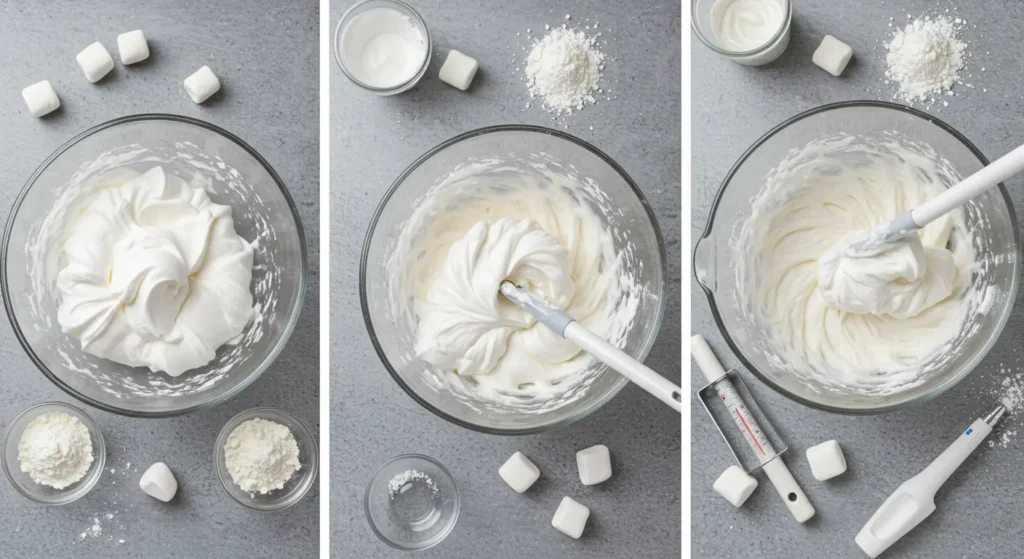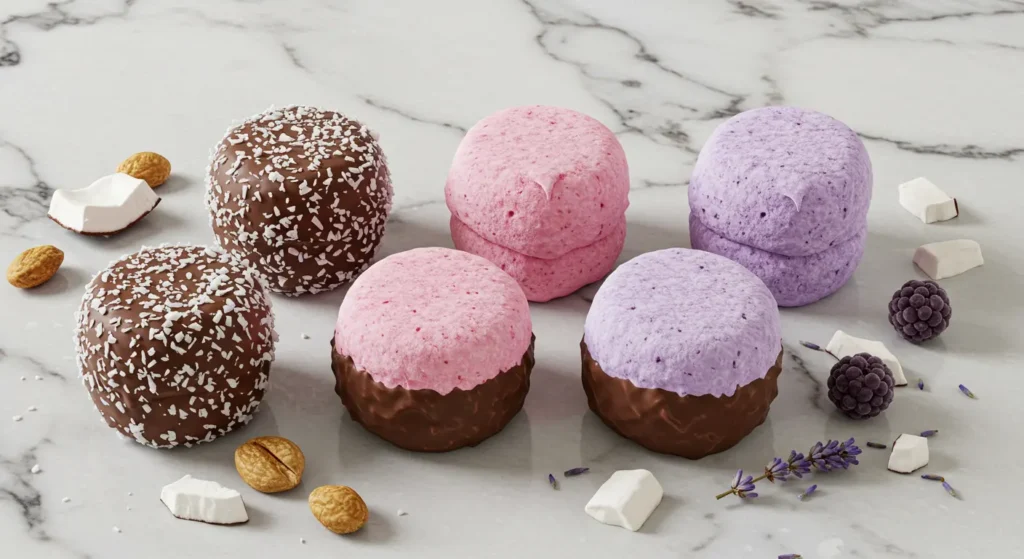Healthy Marshmallows – Why This Recipe?
As Chef Greeny, I’ve always had a sweet tooth that sometimes got the better of me. Years ago, when I discovered my sensitivity to processed sugars, I thought I’d have to say goodbye to many of my favorite treats—marshmallows being one of them. Store-bought marshmallows are typically loaded with corn syrup, artificial flavors, and preservatives that didn’t align with my new health goals.
That’s when my journey to create healthy marshmallows began. After countless kitchen experiments (and quite a few sticky disasters!), I finally perfected recipes that deliver the same fluffy, melt-in-your-mouth texture without the processed ingredients. What started as a personal health necessity became a passion for creating better-for-you versions of classic treats.
In this post, I’ll share my favorite healthy marshmallow recipes that use natural sweeteners, clean ingredients, and innovative techniques. You’ll learn how to make marshmallows that aren’t just healthier alternatives but delicious treats in their own right. Whether you’re looking to reduce refined sugar, avoid artificial ingredients, or simply try something new, these recipes will change how you think about this classic confection.
Healthy Marshmallows – Ingredients and Preparation
Ingredients List

Base Recipe (Makes about 24 marshmallows):
- 1 cup filtered water, divided
- 3 tablespoons grass-fed gelatin (vegetarian option: agar-agar powder)
- 1 cup pure maple syrup (substitute options: honey or coconut nectar)
- 1 teaspoon vanilla extract
- ¼ teaspoon sea salt
- 2 tablespoons arrowroot powder or organic cornstarch for dusting
Equipment needed:
- Stand mixer with whisk attachment
- Candy thermometer
- 8×8 inch baking dish
- Parchment paper
- Sifter
Substitution options:
- For vegan marshmallows: Replace gelatin with equal amounts of agar-agar powder
- For paleo-friendly: Use honey instead of maple syrup
- For sugar-free option: Use monk fruit syrup or allulose syrup (texture may vary slightly)
- For keto-friendly: Use allulose or erythritol-based syrup (reduce amount by 25% and add 10 drops liquid stevia)
Step-by-Step Instructions
- Prepare your pan: Line an 8×8 inch baking dish with parchment paper, allowing excess to hang over the sides. Sift a thin layer of arrowroot powder over the bottom. This prevents sticking and makes removal easier. Tip: Slightly dampen the baking dish first so the parchment paper adheres better.
- Bloom the gelatin: Pour ½ cup of cool filtered water into the bowl of your stand mixer. Sprinkle the gelatin evenly over the water’s surface and allow it to bloom for 10 minutes. This step is crucial for achieving the perfect marshmallow texture. Tip: Don’t stir the gelatin into the water; let it sit undisturbed to properly hydrate.
- Prepare the syrup: In a medium saucepan, combine the remaining ½ cup water, maple syrup, and sea salt. Clip a candy thermometer to the side of the pan and heat the mixture over medium heat until it reaches 240°F (soft ball stage). Tip: Avoid stirring once the mixture begins to boil as this can cause crystallization.
- Combine: With the mixer on low speed, slowly and carefully pour the hot syrup into the bloomed gelatin. Once all syrup is added, gradually increase the speed to high. Tip: Pour the syrup down the side of the bowl rather than directly onto the whisk to prevent splattering.
- Whip to perfection: Continue beating on high speed for 10-12 minutes until the mixture becomes thick, fluffy, and has tripled in volume. Add the vanilla extract during the final minute of mixing. Tip: The mixture should form medium-stiff peaks and be just barely warm to the touch.
- Transfer and set: Working quickly, use a spatula to transfer the marshmallow mixture to your prepared pan. Smooth the top with a lightly oiled spatula. Tip: If the mixture is sticking too much, lightly oil your tools or dampen them with water.
- Dust and rest: Sift a light layer of arrowroot powder over the top. Let the marshmallows set uncovered at room temperature for at least 4 hours or preferably overnight. Tip: Avoid covering as this can create condensation and make your marshmallows sticky.
- Cut and finish: Once set, lift the marshmallow slab out using the parchment paper overhang. Using a sharp knife lightly dusted with arrowroot powder, cut into desired shapes. Tip: Clean your knife between cuts for the cleanest edges.
Notes and Tips
- Storage: Store in an airtight container at room temperature for up to 1 week. Place parchment paper between layers to prevent sticking.
- Serving suggestions: These marshmallows are perfect for hot chocolate, s’mores, or eaten on their own as a treat.
- Make-ahead instructions: These can be made up to 1 week in advance of an event. For longer storage, you can freeze them for up to 3 months in an airtight container with parchment between layers.
- Troubleshooting: If your marshmallows are too soft, you likely didn’t reach the correct temperature for your syrup. If they’re too firm, you may have used too much gelatin.
Healthy Marshmallows – Nutritional Information

Nutrition Facts (Per Serving – 1 large marshmallow)
- Calories: 35
- Carbohydrates: 8g
- Protein: 1g
- Total Fat: 0g
- Saturated Fat: 0g
- Unsaturated Fat: 0g
- Trans Fat: 0g
- Fiber: 0g
- Sugar: 7g
- Cholesterol: 0mg
- Sodium: 12mg
Nutritional benefits compared to store-bought marshmallows:
| Nutrient | Healthy Homemade | Store-Bought |
|---|---|---|
| Calories | 35 | 90 |
| Added sugars | 7g (natural) | 17g (refined) |
| Artificial ingredients | None | Several |
| Protein | 1g | 0g |
These homemade healthy marshmallows contain significantly fewer calories and sugar than commercial varieties. They also offer small amounts of minerals and amino acids from gelatin that store-bought versions lack.
Healthy Marshmallows – History and Cultural Significance
Marshmallows have a fascinating history that dates back to ancient Egypt around 2000 BCE. The original “marshmallow” was a medicinal confection made from the root of the marshmallow plant (Althaea officinalis), which was used to soothe sore throats and treat various ailments. The sap from this plant created a sticky, sweet substance that healers mixed with honey for medicinal purposes.
By the 1800s, French confectioners had refined the recipe, whipping the marshmallow sap with egg whites and sugar to create a more recognizable treat. As demand grew, manufacturers sought more efficient production methods and eventually replaced the actual marshmallow root with gelatin, which provided the same texture but was easier to source and work with.
Today’s commercial marshmallows bear little resemblance to their healthful origins. The medicinal root has been replaced with corn syrup, sugar, and artificial additives. My healthy marshmallow recipes represent something of a full circle—returning to more natural ingredients while maintaining the beloved texture and taste.
Across different cultures, similar confections exist:
- In Turkey and the Middle East, Turkish Delight (lokum) shares textural similarities
- In Japan, mochi provides a comparable chewy, soft experience but is made from rice
- In Russia, pastila, made from fruit puree and egg whites, offers a similar light, airy quality
My healthy marshmallow recipes honor this rich history while adapting to modern nutritional knowledge and preferences.
Healthy Marshmallows – Creative Variations
1. Chocolate-Dipped Coconut Marshmallows
This variation adds healthy fats and antioxidants from dark chocolate and coconut.
Additional Ingredients:
- 2 tablespoons coconut flour (added to the dusting mixture)
- ¼ cup unsweetened shredded coconut
- 4 oz dark chocolate (70% or higher), melted
- 1 tablespoon coconut oil
Method: Follow the base recipe, but fold in the shredded coconut just before transferring to the pan. After cutting the set marshmallows, dip half of each marshmallow in melted chocolate mixed with coconut oil. Place on parchment paper and refrigerate until the chocolate sets.
Nutritional Changes: Adds 2g healthy fats, 1g fiber, and antioxidants from dark chocolate per serving.
2. Superfood Berry Marshmallows
This version incorporates antioxidant-rich berry powder for color, flavor, and nutrients.
Additional Ingredients:
- 2 tablespoons freeze-dried berry powder (strawberry, raspberry, or blueberry)
- 1 teaspoon lemon juice
- Optional: 1 tablespoon grass-fed collagen peptides for added protein
Method: Add the berry powder and lemon juice during the final minute of whipping. The acid in the lemon juice helps preserve the vibrant color of the berries. If using collagen, add it along with the gelatin at the beginning.
Nutritional Changes: Adds antioxidants, vitamins C and K, and an additional 2g protein if using collagen.
3. Adaptogenic Calm Marshmallows
This version incorporates herbs known for their stress-relieving properties.
Additional Ingredients:
- 1 teaspoon ashwagandha powder
- ½ teaspoon chamomile extract
- ¼ teaspoon lavender (culinary grade), finely ground
- 1 tablespoon honey (optional, for additional sweetness)
Method: Add the adaptogenic herbs during the final minute of whipping. These marshmallows make an excellent addition to evening tea or as a pre-bedtime treat.
Nutritional Changes: Adds adaptogens that may support stress reduction and improved sleep quality (though contains negligible changes to macronutrients).
Healthy Marshmallows – Frequently Asked Questions

Can I freeze healthy marshmallows?
Yes! These healthy marshmallows freeze surprisingly well. Place them in an airtight container with parchment paper between layers and freeze for up to 3 months. Allow them to thaw at room temperature for about 20 minutes before consuming. The texture may change slightly, becoming a bit more dense, but they’ll still be delicious.
What can I substitute for maple syrup?
Honey works extremely well as a 1:1 substitute for maple syrup, though it will impart a distinct honey flavor. Coconut nectar is another excellent option that provides a more neutral taste. For a low-carb version, allulose syrup or monk fruit syrup can work, though you may need to adjust the amount (use about 25% less) and add a few drops of liquid stevia to reach the desired sweetness.
How long does it take to prepare healthy marshmallows?
Active preparation time is about 25-30 minutes. However, the marshmallows need to set for at least 4 hours or overnight. Plan for this setting time when preparing for an event.
Will these marshmallows toast like regular marshmallows?
Yes! These healthy marshmallows do toast and brown over a fire, though they may toast a bit faster than commercial marshmallows due to the different sugar content. Keep a close eye on them when toasting to prevent burning.
Are these marshmallows suitable for people with diabetes?
While these marshmallows use natural sweeteners instead of refined sugar, they still contain carbohydrates that will affect blood sugar. The versions made with allulose or monk fruit syrup are better options for those monitoring blood glucose levels, but individuals with diabetes should consume any sweet treat in moderation and consult with their healthcare provider.
Can I use these healthy marshmallows in recipes that call for regular marshmallows?
In most cases, yes. These healthy marshmallows work well in hot chocolate, s’mores, and as toppings. However, for recipes that require melting (like Rice Krispie treats), they behave slightly differently. They will melt, but the texture may be a bit different than with commercial marshmallows. You may need to adjust the amount used or the melting time.
Healthy Marshmallows – Final Thoughts
Creating your own healthy marshmallows at home is truly a game-changer for anyone who loves this classic treat but wants to avoid the artificial ingredients and excessive sugars found in commercial versions. The recipes I’ve shared bring marshmallows back to their wholesome roots while maintaining the fluffy, pillowy texture we all love.
What makes these healthy marshmallows special isn’t just what they lack (artificial ingredients, corn syrup, and excessive processing), but what they contain—quality proteins from gelatin or plant-based alternatives, natural sweeteners that your body processes more effectively than refined sugars, and the potential for customization with functional ingredients like adaptogens or antioxidant-rich berries.
Remember that making marshmallows is both a science and an art. Your first batch might not be perfect, but with practice, you’ll develop a feel for the process. Don’t be afraid to experiment with flavors, colors, and add-ins to create your own signature variety.
I encourage you to try these recipes and share your results with friends and family—many will be amazed that healthy and marshmallows can exist in the same sentence! Leave a comment below with your favorite variation or any creative ways you’ve incorporated these treats into your recipes. Your journey to healthier sweets is just beginning!





3 thoughts on “7 Healthy Marshmallows Recipes That Will Transform Your Sweet Treats”